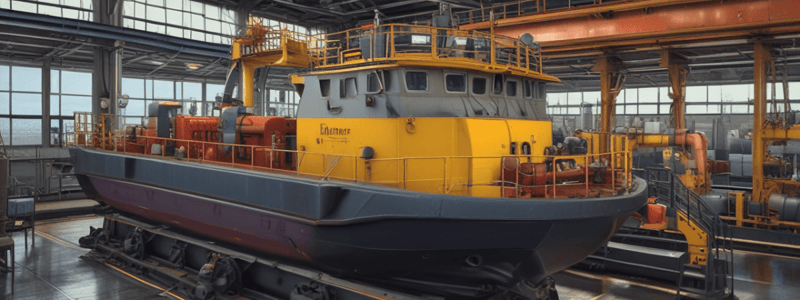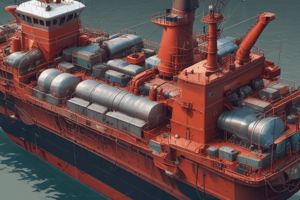Podcast
Questions and Answers
What is the purpose of atomisation in the combustion of fuel in a diesel engine?
What is the purpose of atomisation in the combustion of fuel in a diesel engine?
Atomisation is the process of breaking up the fuel into fine droplets to increase the surface area and improve the mixing of fuel and air, which enhances the combustion process.
How does the compression ratio of a diesel engine affect the combustion process?
How does the compression ratio of a diesel engine affect the combustion process?
The compression ratio of a diesel engine affects the combustion process by influencing the temperature and pressure reached during the compression stroke, which is necessary for the auto-ignition of the fuel-air mixture.
What is the purpose of the labyrinth glands in a diesel engine turbocharger?
What is the purpose of the labyrinth glands in a diesel engine turbocharger?
The labyrinth glands in a diesel engine turbocharger are designed to prevent the leakage of compressed air and exhaust gases between the stationary and rotating components of the turbocharger.
Explain the role of the diffuser in a diesel engine turbocharger.
Explain the role of the diffuser in a diesel engine turbocharger.
Describe the function of the thrust bearing in a diesel engine turbocharger.
Describe the function of the thrust bearing in a diesel engine turbocharger.
Explain the principle of operation of a simple hydraulic governor in a diesel engine.
Explain the principle of operation of a simple hydraulic governor in a diesel engine.
How does the transfer of gas force from the piston crown to the crankshaft occur in a four-stroke diesel engine?
How does the transfer of gas force from the piston crown to the crankshaft occur in a four-stroke diesel engine?
Describe in detail the operation of the overspeed trip sketched in part (a), including how it functions to prevent overspeeding.
Describe in detail the operation of the overspeed trip sketched in part (a), including how it functions to prevent overspeeding.
Explain the process of atomization that occurs in a fuel injector nozzle, and why it is important for efficient combustion.
Explain the process of atomization that occurs in a fuel injector nozzle, and why it is important for efficient combustion.
What four key factors influence the separation efficiency of a centrifugal oil purifier or separator?
What four key factors influence the separation efficiency of a centrifugal oil purifier or separator?
Describe how oil loss can occur in a centrifugal oil separator, and methods to minimize this undesirable loss.
Describe how oil loss can occur in a centrifugal oil separator, and methods to minimize this undesirable loss.
List and explain the key factors that determine the discharge cycle frequency of an engine lubricating oil purifier.
List and explain the key factors that determine the discharge cycle frequency of an engine lubricating oil purifier.
Analyze the potential reasons that could cause fluctuations or variations in the oil level reading of a marine diesel engine's main lubricating oil sump.
Analyze the potential reasons that could cause fluctuations or variations in the oil level reading of a marine diesel engine's main lubricating oil sump.
Using a labeled sketch, describe how an air-operated radial tyre-type clutch functions to engage and disengage a marine diesel propulsion engine.
Using a labeled sketch, describe how an air-operated radial tyre-type clutch functions to engage and disengage a marine diesel propulsion engine.
Explain why it is critical to supply lubricating oil to the main reduction gears before they begin rotating, and what monitoring techniques can detect gear wear.
Explain why it is critical to supply lubricating oil to the main reduction gears before they begin rotating, and what monitoring techniques can detect gear wear.
Flashcards are hidden until you start studying




